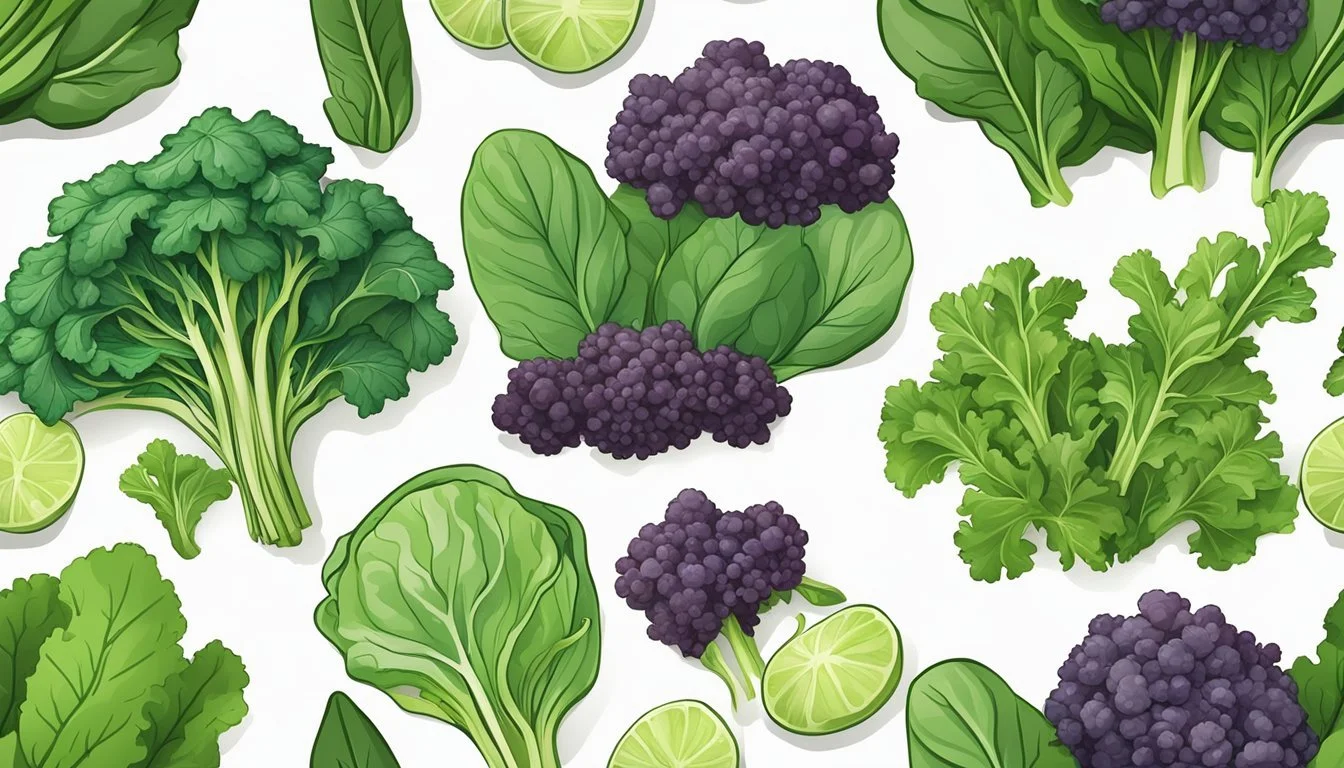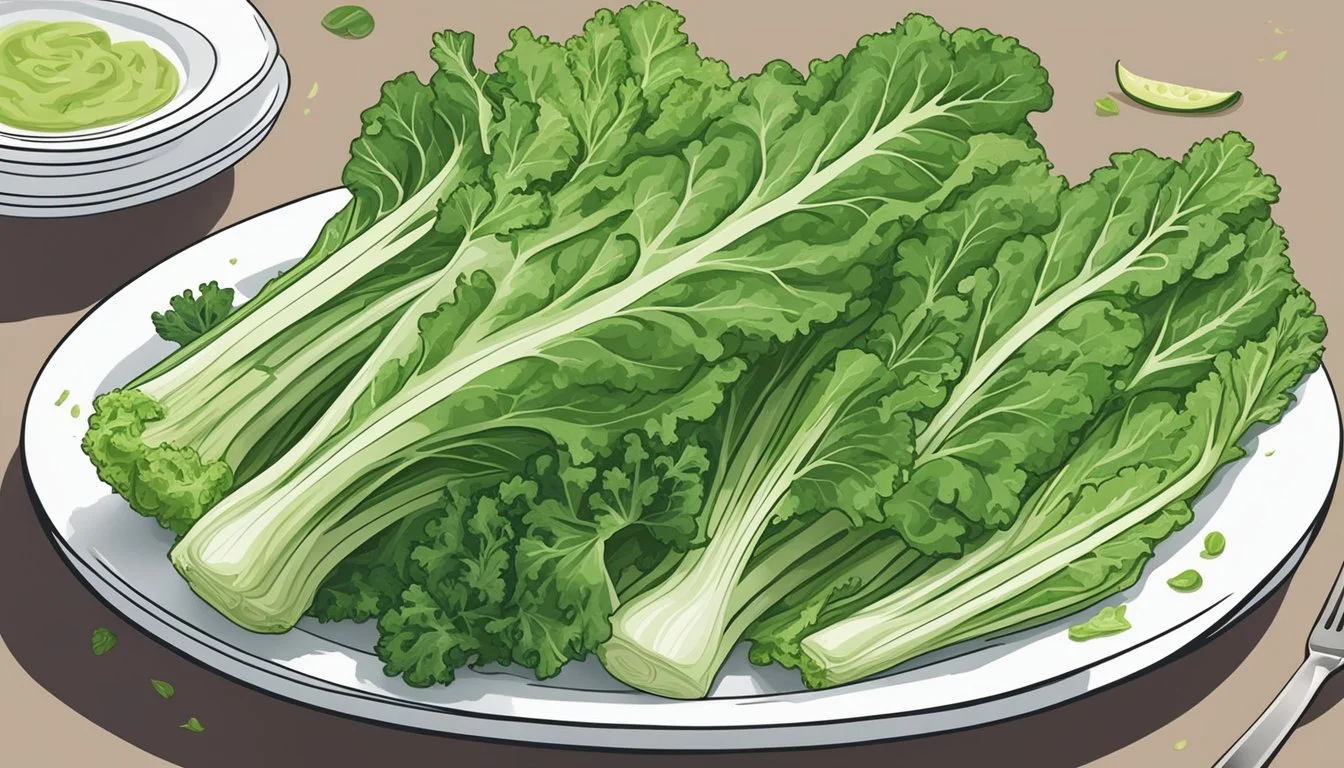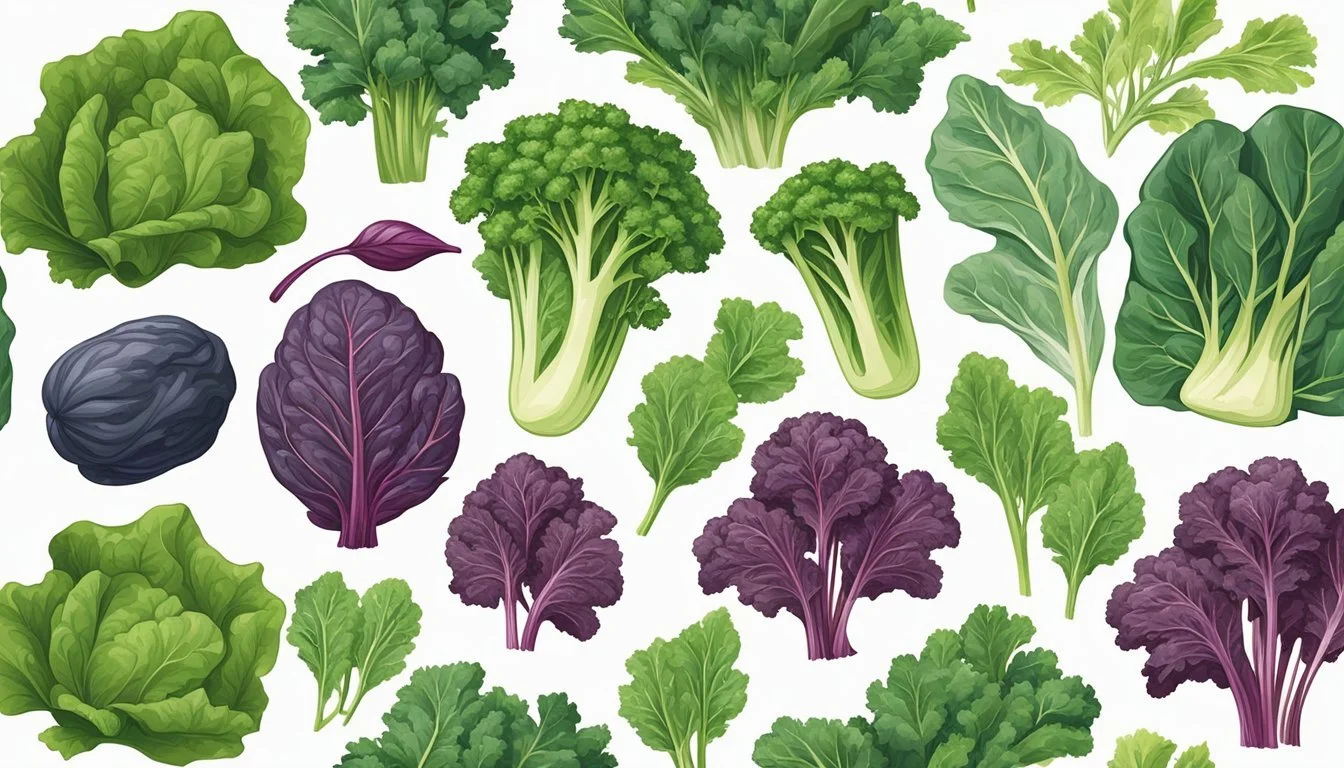Escarole Substitutes
Top Alternatives for Your Recipes
Escarole, a leafy green vegetable belonging to the endive family, is known for its slightly bitter taste and versatility in the kitchen. Often used in Italian cuisine, escarole can enhance soups, salads (What wine goes well with salads?) , and pasta dishes (What wine goes well with pasta dishes?) with its robust flavor and nutritional profile, offering benefits such as vitamins A, C, and K. As a vegetable that may not always be readily available in every grocery store or might be out of season, cooks often seek suitable substitutes that can mimic escarole’s distinct qualities in various recipes.
Radicchio arises as a popular replacement with its burgundy leaves and white ribs, offering a similar bitterness that pairs well with other components of green salads and acts as a suitable addition to hot dishes. On the other hand, kale stands out as an alternative due to its thick, nutrient-dense leaves that soften nicely when cooked, allowing it to be used interchangeably with escarole in cooked dishes like stews and braises. When a milder flavor is sought, other substitutes such as romaine or butter lettuce can provide the desired texture in sandwiches, while still maintaining the essence of a dish.
Identifying Escarole
Escarole, a leafy green vegetable, is a member of the chicory family and is distinguished by its characteristic taste and texture. This section will guide you through its distinct features, from the flavor nuances it brings to dishes to its place within the chicory family’s varied lineup.
Characteristic Tastes and Textures
Escarole is known for its bitter taste which is often milder than other chicory family members. The vegetable exhibits a unique dual texture with crunchy outer leaves that hold up well in cooking, and tender inner leaves that are typically used fresh in salads.
Outer leaves: Crisp and coarser with a pronounced bitterness.
Inner leaves: Softer and less bitter, adding a delicate touch to raw preparations.
Escarole in the Chicory Family
Escarole is part of the chicory family, which includes a range of leafy vegetables known for their bitter taste and crunchy texture. Its place within this family is signified by its broad, green leaves and its ability to intermingle well with other flavors, particularly in Italian cuisine.
Family characteristics: Members of the chicory family, such as radicchio, are often used interchangeably due to their bitterness and crunchy leaves.
Escarole's versatility: It can be eaten raw or cooked, which makes it a versatile ingredient in the kitchen.
By understanding these distinctions, chefs and home cooks alike can better utilize escarole in their culinary ventures.
Culinary Uses of Escarole
Escarole, a leafy green vegetable belonging to the chicory family, is lauded for its versatility in both fresh and cooked dishes. It holds a prominent place in Italian cuisine, where its slightly bitter taste enriches an array of recipes.
Escarole in Salads
In salads, escarole serves as a robust green, capable of adding both texture and a mildly bitter flavor that pairs well with sweeter dressings and fruits. It is commonly used in Italian salads, where its broad, crispy leaves are often combined with other greens to create a balanced flavor profile. Escarole's hardiness allows it to stand up to heavier ingredients like nuts, cheese, or protein without wilting, making it a favored choice for substantial salad offerings.
Salad Pairings:
Sweet elements: pears, apples, dried cranberries
Proteins: grilled chicken, pancetta, anchovies (What wine goes well with anchovies?)
Dressings: balsamic vinaigrette, citrus-based dressings
Cooked Escarole Dishes
Escarole's ability to maintain its structure when cooked makes it an excellent addition to hot dishes, such as soups, Italian wedding soup, and pasta dishes. It typically wilts down to a tender texture, which allows it to blend seamlessly into the dish while still contributing a subtle bitterness that complements rich and savory flavors.
Cooking Applications:
Soups: Italian Wedding Soup, minestrone
Pasta: garlic and olive oil sauté, cannellini bean pasta
Side Dishes: sautéed as a side with garlic and chili flakes
Cooked escarole becomes silky, allowing it to integrate well into the broth of soups or the sauce of pasta dishes, enhancing these meals with both nutritional value and depth of flavor. Whether served raw in a fresh salad or cooked into a warming Italian meal, escarole proves to be an indispensable ingredient for culinary enthusiasts.
Nutritional Profile of Escarole
Escarole, a leafy green belonging to the chicory family, is not just a versatile ingredient but also a power-packed nutritional option. It is often praised for its low-calorie count while being rich in essential nutrients.
Micronutrients and Fiber: Escarole contributes significantly to daily fiber needs. In particular, two raw cups (approximately 85 grams) of escarole provide about 12% of the daily value (DV) for fiber. This aids in digestive health and helps maintain satiety.
Vitamins: A notable feature of escarole is its abundance of vitamins, especially Vitamins A, C, and K. Vitamin K is vital for bone health and plays a crucial role in blood clotting processes. A serving can deliver a substantial percentage of these vitamins, which act as antioxidants as well. These antioxidants help to combat oxidative stress in the body, providing health benefits and potentially reducing the risk of certain diseases.
Nutrients Benefits Fiber Supports digestion and satiety Vitamin A Benefits eye health and immune function Vitamin C Essential for collagen production, immunity, and repair Vitamin K Critical for bone health and wound healing
In addition to vitamins and fiber, escarole is a good source of minerals and phytonutrients. These compounds are involved in numerous bodily functions, contributing to overall well-being.
It’s important to note that while escarole can contribute to overall health due to its nutrient density, it should be included as part of a balanced diet. Regular consumption of escarole can be a practical way to increase the intake of several vitamins and minerals necessary for maintaining good health.
Suitable Escarole Substitutes
When a recipe calls for escarole and it's not on hand, one can find several leafy greens that provide a similar taste and texture. The right substitute depends on how the escarole is intended to be used—raw, such as in salads, or cooked in hot dishes.
Substitutes for Raw Escarole
For raw dishes, the texture and flavor of leafy greens are paramount. Arugula offers a peppery taste, similar to the mild bitterness of escarole, and works well in salads. Frisee and Baby kale, with tender qualities, can also mimic the less bitter inner leaves of raw escarole. Below is a quick reference table:
Raw Escarole Substitute Flavor Profile Texture Use-case Arugula (rocket salad) Peppery, slightly bitter Tender Salads, sandwiches Frisee (curly endive) Mildly bitter Crisp Salads, garnishes Baby kale Mildly bitter Tender Salads, smoothies
Substitutes for Cooked Escarole
In cooked preparations, kale and chard (Swiss chard) hold up well to heat and offer a suitable texture and robustness, matching escarole's performance in soups and sautés. Mustard greens and collard greens bring a pleasant bitterness and substantial leaf structure that stands up to cooking. Radicchio can add a colorful touch and a more pronounced bitter flavor that pairs well with the richness of cooked dishes.
Here are a few examples:
Cooked Escarole Substitute Flavor Profile Texture Best Used In Kale Earthy, slight bitterness Hardy Soups, stews, sautés Chard (Swiss chard) Mild, slightly sweet Tender yet sturdy Braises, gratins Mustard greens Peppery, sharp bitterness Hardy Stir-fries, braised dishes Collard greens Mildly smoky, bitter Firm Slow-cooked dishes Radicchio Bitter, spicy Crisp Risottos, pasta, grilled sides
Opting for these substitutes not only adapts recipes for availability but also allows for customized flavor profiles and nutritional benefits.
Exploring Bitter and Peppery Flavors
When it comes to substituting escarole in recipes, understanding the balance between bitter and peppery flavors is pivotal. These tastes can add depth and complexity to a dish, but they must be moderated to appeal to the palate.
Managing Bitterness in Greens
The bitterness in greens such as escarole, radicchio, and mustard greens can be managed to achieve a pleasant taste profile. Radicchio, with its rich purple leaves and pronounced bitter flavor, can be mellowed out by grilling or roasting, which brings out a sweeter, more caramelized aspect. Alternatively, mustard greens offer a mildly bitter taste but can be softened by sautéing with ingredients that have an earthy flavor, like potatoes or pears.
For a milder flavor, greens such as chard may be used; this versatile vegetable carries a hint of bitterness but lacks the strong peppery bite of some other substitutes, making it a good candidate for balancing dishes with more subtle flavors.
Accentuating Flavors with Complementary Ingredients
Complementary ingredients play a significant role in either mitigating or accentuating the bitter and peppery flavors of greens. For instance:
Lemon juice: Adds a refreshing zest that can counteract bitterness.
Olive oil: Its fruity richness complements the peppery undertones of greens like kale, which offers a mild peppery flavor.
Walnuts: The nutty and earthy taste pairs well with the slight bitterness of greens, and can be added to salads for a textural contrast.
Avocado: The creamy mildness of avocado can harmonize the stronger flavors found in bitter greens.
Using these ingredients can elevate a simple dish of greens into a complex and satisfying meal.
Selecting Substitutes Based on Texture
When looking for escarole substitutes, one must consider the texture to ensure culinary consistency. The goal is to match the characteristic crunchy texture of escarole, especially for dishes such as green salads.
Finding Crunchy Alternatives
For those who appreciate escarole's crunch in salads, kale stands out as an excellent option. Curly kale, in particular, with its robust leaves, offers a similar bite and works well as a raw substitute. Here are some crunchy alternatives:
Kale: A hardy green providing a satisfying crunch.
Romaine Lettuce: Crisp and sturdy, perfect for salads.
Butter Lettuce: Though softer, it can add mild crunch when used in the inner, more crisp leaves.
Use these alternatives to maintain the textural integrity of your dish when escarole is not available.
Choosing Substitutes with Similar Mouthfeel
While not as crunchy as kale, spinach possesses a texture that softens nicely when cooked, resembling the tender mouthfeel of cooked escarole. For dishes that require a similar wilted texture, one might consider:
Spinach: Silkier when cooked, yet offers a textural contrast in raw applications.
Swiss Chard: It wilts similarly to escarole when heated, with a slight vein crunch.
These substitutes help preserve the intended mouthfeel of recipes calling for escarole, be it in cooked dishes or fresh salads.
Incorporating Leafy Greens in Diverse Cuisines
The integration of leafy greens in culinary traditions across the globe varies significantly, with each cuisine embracing different greens for their unique flavors and textures. Key substitutes play an essential role when traditional ingredients are unavailable, ensuring that the essence of the dish is maintained.
Mediterranean Delights
The Mediterranean palate is rich in greens like escarole and bavarian endive, which feature prominently in dishes from salads to pasta. For example, when creating a traditional Mediterranean salad, one might typically reach for escarole for its crunchy and slightly bitter taste. If escarole is out of reach, consider using dandelion greens as they offer a similar bitterness and are often used in Mediterranean cuisines to complement fatty meats and rich cheeses.
Mediterranean Dish Traditional Green Substitute Green Pasta Escarole Dandelion Greens Casseroles Bavarian Endive Silverbeet Salads Escarole Dandelion Greens
In pasta dishes, greens are not just garnishes but stand as a central component. For instance, replacing escarole with silverbeet in casseroles maintains the volume and a similar texture, allowing for a seamless integration into Mediterranean recipes.
Asian Inspirations
Asian cuisine often features Chinese cabbage, known for its sweet flavor in stir-fries and dumplings. When unavailable, turnip greens can be a worthy replacement, providing a peppery punch to Chinese dishes.
Asian Dish Traditional Green Substitute Green Stir-Fries Chinese Cabbage Turnip Greens Dumplings Chinese Cabbage Turnip Greens
For those preparing an Asian salad or dish that traditionally uses Chinese cabbage, a potential alternative is dandelion green. It delivers the leafy texture and a flavor intensity that elevates the salad while maintaining authenticity.
Each cuisine holds leafy greens in high regard, considering them integral to imparting traditional flavors and textures. Knowledge of suitable greens and their substitutes is paramount for any culinary enthusiast seeking to honor the dish's roots while navigating ingredient availability.
Health Considerations When Choosing Substitutes
When selecting a substitute for escarole, individuals should consider the nutritional profile of alternatives to ensure the maintenance of dietary balance. Escarole is known for its high nutrient content that supports overall health, and ideal substitutes should offer similar benefits.
Fiber: A key component for digestion, fiber is plentiful in escarole. Substitutes such as kale and spinach provide robust amounts of dietary fiber, aiding in digestive health.
Vitamins and Minerals: A spectrum of vitamins including A, B6, and C, alongside minerals like iron and potassium, are present in escarole. Substitutes must be chosen with these nutrients in mind. Kale is a powerhouse, rich in vitamins A, C, K, and minerals like potassium and iron.
Antioxidants and Phytonutrients: Known for their role in combating oxidative stress, antioxidants and phytonutrients are essential for overall well-being. Spinach, often termed a superfood, offers these compounds, making it a worthy substitute.
When considering substitutes, it's not only the presence of these nutrients but their bioavailability and the manner in which they are prepared that matters. For example, vitamin C is heat sensitive, so raw or lightly cooked substitutes would offer more of this vitamin.
Below is a summary of suitable escarole substitutes with their respective health benefits:
Substitute Fiber Potassium Vitamins Minerals Antioxidants Kale High High A, C, K Iron High Spinach High Moderate A, C, B6 Iron High
While many leafy greens can serve as substitutes, the specific choice should depend on the desired nutrient emphasis and how the greens are incorporated into the diet.
Conclusion
When escarole is not available, one has a variety of leafy greens at their disposal to serve as fitting stand-ins. A cook may choose radicchio for its burgundy leaves and a distinct bite, which complements green salads and can enhance the flavor profile of pasta and pizza when used as a topping.
Collard greens present a slightly bitter taste and offer thicker foliage, making them suitable for recipes that require a sturdier structure. Similarly, one might opt for kale as a robust alternative due to its hearty leaves. Kale can be used in a diverse range of culinary applications, including soups, stews, and meatballs, often employed in a 1:1 ratio.
For dishes that benefit from a more subdued bitterness, chard or baby kale is recommended due to their tender quality, ideal for recipes that call for less hardy greens. Mustard greens also provide a touch of bitterness, coupled with nutritional benefits like vitamins A, C, and K.
In summary, one can consider several suitable substitutes for escarole, each bringing its unique characteristics to a dish:
Radicchio: Bold and colorful, excellent for salads and garnishes.
Collard Greens: Thick and hearty, ideal for extended cooking.
Kale: Versatile and nutritious, a straight swap for escarole.
Chard: Mild and soft, suitable for delicate preparations.
Mustard Greens: Distinctive flavor, a source of various vitamins.
Each alternative offers a fresh take on traditional recipes and can be incorporated according to the cook's preference for texture and flavor intensity, enriching the culinary experience.









